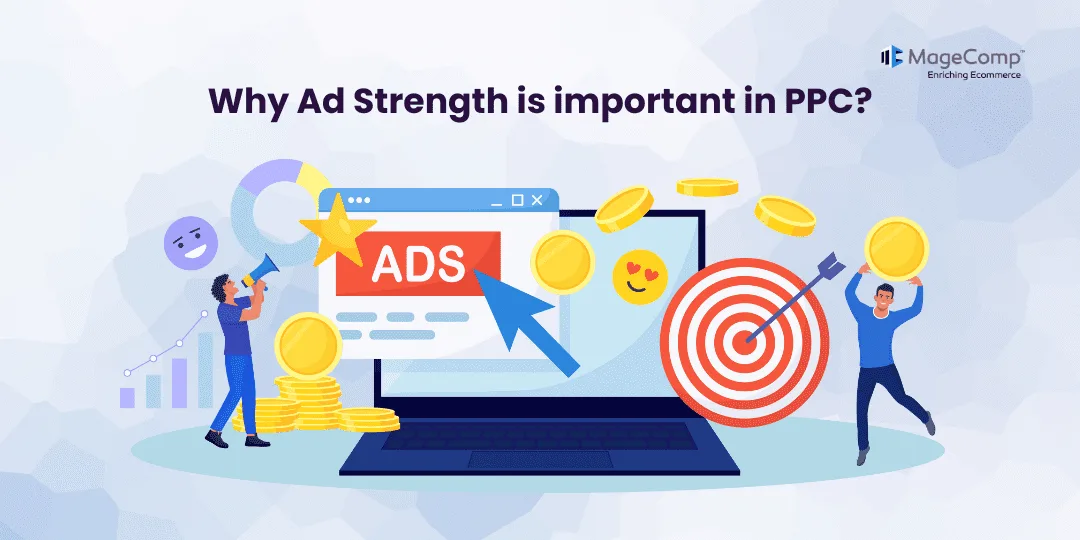As a digital marketer, you would agree to the fact that Google Ads are the core of every digital marketing strategy. But have you ever felt skeptical about its important metric, Ad Strength? You are not the only one who refers to it as a pointless metric. Many advertisers feel the same about this metric.
Google Ads effectively helps businesses to reach their targeted audiences via the large online market. On the other hand, Google Ads also allows digital marketers to compete for keywords relevant to their offered services or products. As a result, the business advertisements are prominently displayed in the search engine result pages whenever a user enters a particular search query.

What is Google Ads Strength?
Though Google Ads lets advertisers compete on their business-relevant keywords, it does not completely rely on the bidding tactics of keyword selection. The Google Ads’ success also relies on the ads’ quality and relevance. This is where the Ad Strength metric comes into the limelight.
Google Ads Strength is a metric that evaluates the relevance and quality of the ads in the campaigns. The Google Ads are rated from Poor to Excellent, evaluating components like descriptions, images, headlines, and ad copies. Google Ads’ goal is to develop impactful and compelling Google ads for businesses that easily connect with their targeted audience.
Concerns Regarding Google Ads’ Strength
The ad strength metric has always been a topic of doubt for digital marketing experts, even though Google has been prominently emphasizing the usefulness of the tool to enhance the ads’ performance.
The reason why marketing experts are doubtful about this metric is that, even with lower Ad Strength, multiple Google Ad campaigns have performed very well and delivered much better outcomes compared to those advertisements with high ad strength scores.
As a result, the debate on the relevance and credibility of this metric has been constantly ongoing.
The concept of Ad Strength has recently sparked skepticism within the industry, leading to a surge in interest among advertisers regarding its potential impact on campaign performance. As marketers seek to maximize the return on investment (ROI) from their advertising efforts, there is a growing need for a thorough comprehension of how metrics like Ad Strength directly influence their ability to achieve their objectives.
How is Ad Strength Calculated?
The Google Ads strength is a vital metric for your ad campaigns as they provide marketers with important data about the significance and effectiveness of the ads.
As we discussed earlier, multiple components like image, heading, ad copy and descriptions are analyzed while calculating the ad strength of the Google Ads.
1. Ad Relevance
This measures how well the ad matches the intent of the user’s search query. The more closely the ad content aligns with the keywords and search terms, the higher the relevance score.
2. Ad Format
This evaluates whether the ad uses the most effective format and features available, such as ad extensions (site links, callouts, structured snippets, etc.), responsive search ads, and more. Utilizing these features can enhance ad strength.
3. Ad Copy Quality
This looks at the quality and variety of the ad copy. Strong ads typically have multiple headline and description variations to appeal to different user intents and improve performance.
4. Keywords
The use of relevant and high-quality keywords in the ad and the match types used also influence ad strength. Keywords should be closely related to the products or services being advertised.
When creating Google Ads, it’s important to use visually appealing images and compelling headlines can significantly increase the Ad Strength. On the other hand, ads with generic content and unattractive graphics may have a lower Ad Strength.
Importance of Ads Strength
1. Relevance to Users
Ad strength is essential in ensuring that your ads are highly relevant to the users’ search queries. When your ad content closely matches what users are looking for, it increases the likelihood of engagement. This targeted messaging is crucial because it aligns with the search intent, making your ads more appealing and useful to potential customers.
As a result, ads with higher relevance tend to see better performance metrics, such as higher click-through rates (CTR), because they resonate more effectively with the audience. This relevance not only enhances user satisfaction but also maximizes the impact of your advertising efforts.
2. Quality Score Improvement
Google Ads uses ad strength as a component in determining the Quality Score of your ads. A higher Quality Score is beneficial because it indicates that your ads are of high quality and relevant to users. This can lead to better ad placements, allowing your ads to appear in more prominent positions on the search results page.
Additionally, a higher Quality Score often results in lower costs per click (CPC), as Google rewards well-optimized ads with cost efficiencies. By focusing on ad strength, you can improve your Quality Score, thereby enhancing your overall ad performance and competitiveness in the ad auction.
3. Cost Efficiency
Improving ad strength is directly linked to cost efficiency in your advertising campaigns. Ads with higher strength are generally more effective, leading to a better return on investment (ROI). This is because they achieve better performance metrics at a lower cost.
With a higher Quality Score, you benefit from reduced CPCs, allowing you to get more value from your advertising budget.
Cost efficiency is crucial for maintaining a sustainable and profitable advertising strategy, and focusing on ad strength helps ensure that you are not overspending while still achieving excellent results.
4. Ad Performance Insights
Ad strength provides valuable insights and actionable feedback on how to improve your ads. Google Ads offers specific suggestions, such as adding more headlines or descriptions, to enhance ad performance.
These insights are based on best practices and data-driven analysis, helping you make informed decisions to optimize your ads.
Continuous monitoring and improvement of ad strength ensure that your ads remain competitive and effective over time. This process of ongoing optimization is essential for adapting to changing market conditions and user behaviors, ultimately leading to sustained ad success.
5. User Experience
Strong ads contribute significantly to a positive user experience. When ads are relevant and well-crafted, they provide users with the information they are looking for, thereby enhancing their overall experience. This improved user experience can lead to higher conversion rates, as users are more likely to engage with ads that meet their needs and expectations.
Additionally, high-quality ads help build trust and credibility for your brand, improving its perception among potential customers. By focusing on ad strength, you ensure that your ads not only perform well but also contribute to a positive interaction with your brand.
6. Competitive Advantage
In a competitive advertising landscape, ad strength can provide a significant edge. Well-optimized ads stand out from the competition, making it easier to capture the attention of potential customers.
This differentiation is crucial in crowded markets where multiple advertisers are vying for user attention.
Strong ads that effectively communicate your unique value proposition can help you attract and retain customers, giving you a competitive advantage. By continuously improving ad strength, you can stay ahead of competitors and maintain a strong presence in the marketplace.
Strategies to Optimize Google Ads
1. Keyword Research and Optimization
Keyword research is crucial for identifying the right terms to target in your ads. Use tools like Google Keyword Planner to find relevant keywords with high search volume and low competition.
Continuously optimize your keyword list by adding new keywords and removing irrelevant ones. Negative keywords play a vital role in ensuring that your ads are not shown for irrelevant searches.
2. Ad Copy and Extensions
Your ad copy is the first thing users see, so it needs to be compelling and relevant. Craft ad copy that highlights your unique selling points and encourages users to click.
Ad extensions provide additional information and can improve your ad’s visibility. Use sitelink, callout, and structured snippet extensions to provide more context and encourage clicks.
3. Landing Page Optimization
Landing pages should be highly relevant to your ad copy and keywords. They should load quickly and provide a seamless user experience.
Ensure that your landing page has a clear call to action (CTA) that aligns with the goal of your ad campaign.
4. Bidding Strategies
Google offers automated bidding strategies like Target CPA and Target ROAS, which use machine learning to optimize bids for conversions or return on ad spend.
Manual bidding allows for more control over individual keyword bids but requires regular monitoring and adjustment.
5. Audience Targeting
Custom audiences allow you to target specific demographics, interests, and behaviors. Remarketing campaigns target users who have previously visited your site, increasing the chances of conversion.
6. Ad Scheduling and Geo-Targeting
Analyze your performance data to determine the best times and locations to run your ads. Ad scheduling allows you to adjust your ad delivery based on user behavior and conversion patterns. Geo-targeting focuses your ad spend on geographic locations where you are likely to get the most conversions.
7. A/B Testing
A/B testing involves creating multiple versions of your ads or landing pages to see which performs best. Test different ad copy, images, and CTAs to optimize your campaigns for better results.
8. Monitor and Analyze Performance
Regularly review your campaign performance data to identify trends and areas for improvement. Focus on key metrics such as CTR, CPC, CPA, and conversion rates. Use this data to make informed decisions about adjusting your bids, keywords, and ad copy.
9. Quality Score Improvement
Quality Score is Google’s rating of the quality and relevance of your keywords, ads, and landing pages. Improve your Quality Score by ensuring your ads are relevant, your expected CTR is high, and your landing page experience is positive.
10. Utilize Advanced Features
Responsive search ads automatically adjust the content of your ads to improve performance. Dynamic search ads generate ads based on your website content, saving time and effort in ad creation.
Closing Phrase
Ad Strength is a powerful diagnostic tool within Google Ads campaigns. It provides advertisers with valuable insights into the quality and relevance of their ads. By harnessing the capabilities of Ad Strength alongside other optimization strategies, advertisers can significantly improve their campaign performance and achieve superior results.









